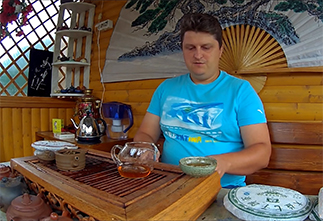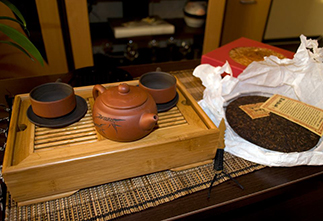Shu Puer 2014 raw material, pressed 2019 "The older, the more aromatic" from "Kaishunhao", 357 g
When warmed up with your breath, you can feel a calm, gentle aroma with woody notes and creamy caramel shades. After washing, the aroma intensifies, dried herbs scalded with boiling water and a light trail of cherry juice are added.
The taste of brewed tea is dense and thick, woody-creamy, with nuances of burnt caramel and camphor. By the 3rd infusion, a persistent woody shade with berry sourness and nuances of nuts dominates.
The tea can withstand 5 full steepings, with a ratio of 7-10 g of tea per 190 ml Yixing clay teapot or gaiwan. Shu puer should be brewed with water at a temperature of 98-100 °C.
The infusion is dark red-brown in color, clean and transparent.
During the tea drinking process, a rich aftertaste with woody-nutty tones sets in.
This puerh gently tones, smoothly warms, gives determination, sobers up and makes the mind clear. Decent quality, balanced delicate taste, and soft tea state make it an ideal tea for every day.
|
Country
|
China |
|
District
|
Xishuangbanna Dai Autonomous Prefecture |
|
Provinces
|
Yunnan (云南) |
|
Manufacturer
|
Кайшуньхао (开顺号) |
|
Raw material production date
|
2014 |
|
Year of pressing
|
2019 |
|
Pressing form
|
Bing Cha (Cake Tea) |
|
Declared weight, g
|
357 |
- Комментарии
- Вконтакте
The question often arises: how to brew puerh correctly? Sometimes the phrase "to get high" is added to it. Moreover, everyone has their own understanding of this phrase. Some mean vigor, and some - intoxication. So how to brew puerh tea correctly? Let's consider several options.
Traveling through the tea mountains, we found ourselves in another land of blue roofs - the village of Zhongcai, which is located in the Menghai district of Yunnan province. According to tradition, we were shown another local tea tree, which, according to the Chinese, is at least a million years old :) The village is very authentic, not designed for tourists, there are many wild pu-erhs there and, of course, we were warmly received. They treated us to local cuisine and tea. We also asked the residents about the prices of tea and how they have changed in recent years.
The tea ceremony occupies a special place in the centuries-old Eastern tradition. And although the essence of this phenomenon remains constant, the nature and external manifestations of the tea ceremony in different nations have their own national characteristics. In each Chinese province, the tea ceremony and the tea used in it are varied: for example, residents of the southern provinces prefer green tea, and residents of the northern provinces - red tea, in Fujian province they more often use Oolong tea, and in Yunnan province Puer tea is widely known.





























































































